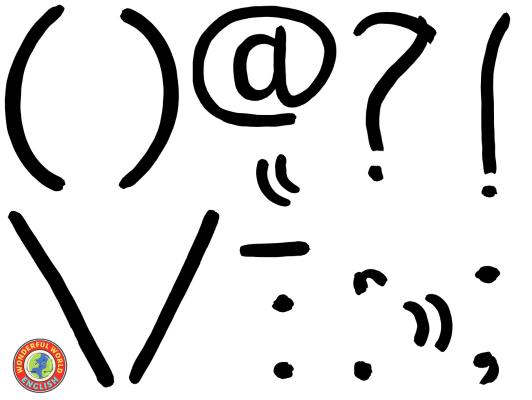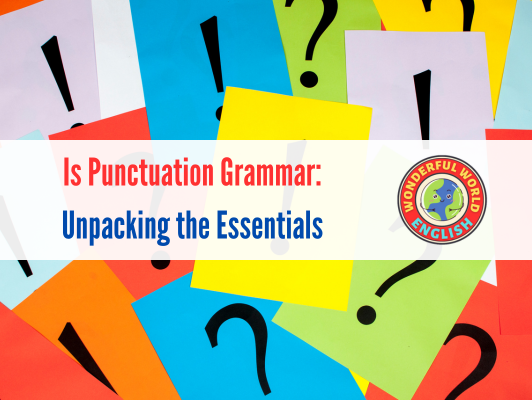Contents
Toggle
Meet David De’ Ath, founder, editor, and writer at Wonderful World English. With his extensive background as an English teacher, David provides valuable insights and practical tips on ESL for students and teachers alike.
Punctuation and grammar are two essential components of writing that ensure clarity and understanding.
While punctuation involves the use of symbols such as periods, commas, and question marks to separate sentences and clarify meaning, grammar is the framework of rules that dictates how words and phrases should be arranged in a language.
Both serve distinct roles in constructing effective communication.
Grammar can be seen as the overarching system that encompasses various aspects of language, including syntax and word order, whereas punctuation is a subset that provides the visual cues needed to understand the text.
Understanding their interplay is critical for proficient writing.
Punctuation might be considered the traffic signals within the grammar system, guiding the reader through the flow of sentences.
When used correctly, punctuation marks contribute to the precision and rhythm of the written language.
Without them, readers might find texts confusing or ambiguous.
However, punctuation alone cannot carry the message, as grammar lays down the foundational structure without which the communication may fall apart.
Key Takeaways
- Punctuation and grammar are distinct but interconnected aspects of writing.
- Proper use of punctuation marks enhances the clarity and rhythm of sentences.
- Grammar provides the structural rules that are crucial for coherent communication.
Understanding Punctuation as a Component of Grammar
Punctuation serves as the toolkit for clarity and rhythm in written language, while grammar structures the foundation for conveying meaning.
The intersection of these elements forms the essence of effective communication.
Defining Punctuation and Grammar
Grammar is the system that structures language, containing sets of rules that dictate how words are used to form sentences and convey meaning.
In contrast, punctuation consists of symbols that enhance the readability and comprehension of sentences by punctuating pauses, ending statements, and separating ideas and components within a sentence.
The Role of Punctuation in Sentences
Punctuation marks are essential in sentences. They guide the reader through the text, indicating stops (periods), pauses (commas), shifts in tone (exclamation points, question marks), or the structure of lists and quotations.
Proper use of punctuation is part of good grammar practice; it allows for precise interpretation of an author’s intended meaning.
Types of Punctuation Marks
Below is a brief overview of common types of punctuation marks and their primary uses:
- Periods (.) signal the end of a sentence.
- Commas (,) indicate a pause, list items, or separate clauses.
- Question Marks (?) denote inquiries.
- Exclamation Marks (!) add emphasis or strong emotion.
- Colons (:) introduce lists, quotations, or explanations.
- Semicolons (;) bridge independent clauses that are closely related.
- Quotation Marks (” “) surround spoken dialogue and direct quotes.
- Apostrophes (‘) show possession or create contractions.
Each mark has specific rules for usage that dictate where and how they should be applied to achieve clarity in written language.
For a guide on some teacher’s grammar tips, check out the link below!
Related: Easy Grammar Tricks: Ultimate Guide for Students

Implementing Punctuation in Various Contexts
The effective use of punctuation is vital across various writing styles, genres, and professional contexts.
It significantly affects the clarity and coherence of both formal and informal texts.
Punctuation in Writing Styles and Genres
Different genres and styles—from academic papers to creative fiction—demand particular conventions in punctuation.
The Chicago Manual of Style provides comprehensive guidelines for formal writing, often preferred by publishers.
In contrast, informal writing, such as social media posts, may take liberties with punctuation for stylistic effect.
However, core punctuation marks such as periods, commas, and question marks are fundamental across all contexts to facilitate clear reading and convey precise meaning.
Common Punctuation Errors and Best Practices
Punctuation errors can lead to ambiguity and misinterpretation.
Common mistakes include:
- Comma splices, where a comma is used to connect two independent clauses instead of a period or semicolon.
- Incorrect apostrophe usage in contractions and possessives.
- Overuse of exclamation points to emphasize a point.
Best practices encourage the use of tools like Grammarly for automated feedback and proofreaders for a professional review of written materials.
Both these resources help to catch and correct errors, ensuring writing skills are polished and effective.
| Punctuation Mark | Common Errors | Best Practice |
|---|---|---|
| Comma (,) | Comma splices | Use for lists, after introductory words, commas for nonrestrictive clauses |
| Semicolon (;) | Overuse or underuse | Link closely related independent clauses |
| Period (.) | Run-on sentences | End a declarative sentence or an abbreviation |
| Apostrophe (‘) | Its vs. it’s; plurals | Use for contractions and to show possession |
Advanced Punctuation Usage
Professionals and students seeking to refine their writing skills should pay attention to advanced punctuation, such as:
- Colons (:) to introduce lists, quotes, or explanations.
- Semicolons (;) for balancing complex lists or closely related independent clauses.
- Dashes (—) to insert additional information or create a strong break in sentence structure.
- Ellipses (…) to indicate a trailing off or an omission of text.
A mastery of these marks allows for nuanced expression and can enhance the reader’s engagement.
The careful application of punctuation is a sign of meticulous writing and is key in achieving both clarity and stylistic flair.
For a comprehensive guide on the BEST books to learn English, check out the link below!
Related: Best Books to Learn English: Top Picks for Everyone

Conclusion
Punctuation is a fundamental component of grammar, essential for crafting clear and effective communication in writing.
While it primarily clarifies and organizes text through visual cues, punctuation must work in tandem with grammatical rules to construct meaningful and coherent sentences.
Understanding and implementing correct punctuation enhances readability and ensures the writer’s intended message is accurately conveyed.
Whether in everyday communication or professional writing, mastery of punctuation and grammar is crucial for anyone who wants to excel in written English.
This dual understanding enables writers to express their ideas more precisely and creatively, ultimately enriching the overall quality of written discourse.
We hope you find value in this information; you can contact us if you require any support.
Have a wonderful day!
Image Attribution: All images licensed via canva.com





